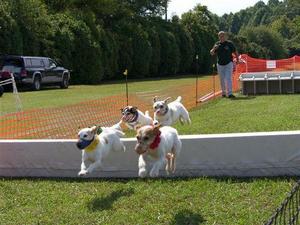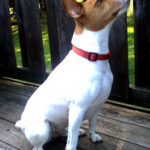Ever wondered just why your Jack Russell does some of those crazy things, like stare at the fridge or the stove for twenty minutes at a time? Or how about suddenly frantically digging at the carpet for no apparent reason? How about the way they almost immediately attack and disembowel every new stuffed toy you’ve ever given them? One of my small females holds our all-time record of 45 seconds to completely rip a toy to shreds and run off with the squeaker.
Jack Russell Terriers were the result of a breeding program begun around 1820 by Parson Jack Russell, who was looking for the perfect terrier to carry on fox hunts. His criteria were fairly broad; he wanted a dog that was mostly white – to prevent the hounds from confusing it with the fox – and with a thick, dense, wiry coat to protect it from wet and cold. The dog should be as long in the body as it was tall at the shoulder, with straight legs and a hardy-looking frame. As the Jack Russell became more popular with huntsmen, two distinct sizes began to emerge. A taller, leggier Jack was preferred by some, because it could run with the horses easily, while others chose the smaller type that could easily fit into a saddlebag or a pouch hung from the shoulder.
Whatever the size a hunter preferred, however, all could agree that the ideal Jack Russell needed to be highly intelligent, energetic, agressive, self-confident, and loud. Silent-hunting Jacks could be a serious problem in the field, because once they had gone to ground after their quarry (meaning gone into the fox’s den to drive it back out), the huntsman had no way of locating the terrier under the ground. Even with a noisy terrier, however, if the den was more than ten or fifteen feet underground, it could be extremely difficult to find them again. Once a Jack has gone after its quarry, most of them refuse to give up, and it is not unheard of for a Jack Russell to starve in a tunnel while waiting out its quarry. Nowadays, we have electronic radio locating collars, but even these systems are not infallible.
Now, obviously, with the increased popularity of this plucky little breed, especially in the last twenty years, we can’t all go out every couple of days or so and run our terriers to exhaustion with a rousing foxhunt! There are probably thousands of people out there who have never seen a live fox except for in a zoo setting. So, what do we do to keep our friends happy, our homes in one piece, and ourselves sane? We take them to a “Terrier Trial.”
Most people probably have a preconceived notion of what constitutes a dog show; after all, most of us have seen the AKC shows on television, with those beautifully groomed creatures trotting gracefully beside their handlers. (At this point, people who are owned by Jack Russells may now pick themselves up off the floor, where they have spent the last few seconds laughing hysterically.) A Terrier Trial, on the other hand, consists of several different events, all held outdoors, no matter the weather. I have been to trials where it was thirty degrees out, spitting snow and sleet, and we all carried on like it was a comfortably breezy 75 or so. I have also been to shows where it was well over 90 in the shade, and the trial chairpersons had to set out numerous large tubs of ice water for cooling down the dogs. Terrier Trials are not for the faint-hearted, but the dogs love them.
There are four events that can be found at every two-day trial. The first of these is racing, and believe me, we are serious about our racing dogs. One lady has a 9 year old female who still races in the senior class, and has an acupuncture appointment two days before the trial to loosen her up. This female has beaten others younger than she by as much as five years, and she loves every second of it.
Racing falls in two sections: flats and hurdles. Flats are run exactly as they sound: the dogs race on a flat, straight course that ranges from 200 to 300 feet in length. Hurdles are run on the same course, with the addition of 3-6 jumps placed at equal intervals down the length of the track. There are six dogs in each race, and they are separated by age, sex, and height.
The second most serious event is Conformation. This, like all other events, starts right after racing is over, and can sometimes last well into the evening, especially at the yearly National Trial in Havre De Grace, Maryland. This is where the owner/handler walks around a ring, and the dog is judged on movement and how it conforms to breed standard, similar to the AKC style. However, the Jack Russell Terrier Club of America (JRTCA) has a much broader breed standard than the AKC typically holds for it’s recognized breeds.
Another standard event is Go-To-Ground. In this event, which simulates what the Jack Russell was originally bred to do, a series of wooden “tunnels” are set up in a pattern with at least three turns, and generally one false end as well. At the true end of the tunnel, the judge waits with a (secure!) cage of rats. Once there, the dog has to “work” the rats for a full minute; i.e., bark, whine, scratch, stare intently, etc. The rats are always kept quite safe, and usually at least one of them will begin to tease the dogs. The fastet time in each class wins.
Lure Coursing is a great favorite with the dogs, and spectators as well. A course is set up using pegs with loops or pulleys at their top. A thin, strong cord is run through these loops and attached to the lure machine so that it creates one long, twisted loop. Then, a piece of common, everyday white plastic trash bag is attached to the lure. Many Jacks have to be allowed to run the course repeatedly until they are too tired to move, otherwise you can’t catch them. The dog with the fastest time wins.
A fairly new event rapidly gaining in popularity is Barn Hunt. An enclosure is built using two to three tiers of hay bales set out into the shape of a capital “E” and surrounded by some type of portable fencing – we use that bright orange vinyl netting. We also cover the “E” with a 10’x20′ canopy with side wall on three sides to help focus the dogs attention. In the hay bales are hidden four PVC tubes; one tube has two rats in it. The handler places the dog on the ground and encourages it to “Get the rat!” The dog with the fastest time wins.
On April 14th, 2007, we will be hosting our first Fun Day. We will have Racing, Go-To-Ground, Lure Coursing, and Barn Hunt. It is a one-day event, and will be held at our farm in Eastern NC. For more information on our fun day, please email [email protected], and we will be happy to send more information on this event. For those outside of our area, the official website of the JRTCA has a listing of all nationally sanctioned trials, as well as links to each state’s affiliate club; these often have trials or fun days that aren’t nationally sanctioned, but are a good way to have fun with your JRT.




